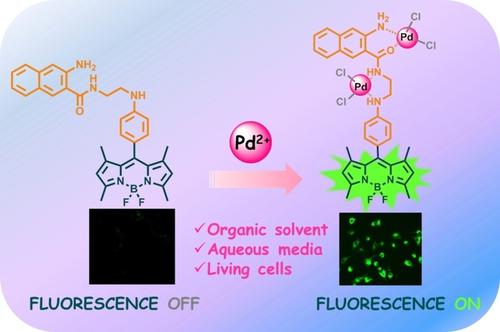当前位置:
X-MOL 学术
›
Chem. Asian J.
›
论文详情
Our official English website, www.x-mol.net, welcomes your
feedback! (Note: you will need to create a separate account there.)
A Boron Dipyrromethene‐Based Fluorescence ‘OFF‐ON’ Probe for Sensitive and Selective Detection of Palladium(II) Ions and Its Application in Live Cell Imaging
Chemistry - An Asian Journal ( IF 3.5 ) Pub Date : 2020-10-27 , DOI: 10.1002/asia.202001144 Xiao‐Fei Chen 1 , Qinhai Ma 2 , Zhoulang Wang 2 , Zeqiang Xie 3 , Yu Song 4 , Yanfang Ma 1 , Zifeng Yang 2 , Xin Zhao 1
Chemistry - An Asian Journal ( IF 3.5 ) Pub Date : 2020-10-27 , DOI: 10.1002/asia.202001144 Xiao‐Fei Chen 1 , Qinhai Ma 2 , Zhoulang Wang 2 , Zeqiang Xie 3 , Yu Song 4 , Yanfang Ma 1 , Zifeng Yang 2 , Xin Zhao 1
Affiliation

|
A novel boron dipyrromethene (BODIPY)‐based fluorescent probe BDP−Pd was designed and synthesized. Upon coordination with Pd2+, the emission of the probe at 508 nm significantly increased, showing an ‘OFF‐ON’ fluorescence response. The complexation of BDP−Pd with Pd2+ in both acetonitrile and aqueous solution were then studied by absorption and fluorescence spectra. The binding stoichiometry between the probe and Pd2+ was found to be 1 : 2, and the binding constant was determined to be 8.5×1010 M−2 and 8.2×1010 M−2 in acetonitrile and aqueous solution, respectively. The probe exhibited a detection limit as low as 0.72 ppb toward Pd2+ with no obvious interference from up to 21 species of common metal ions, suggesting BDP−Pd as a sensitive and selective fluorescent probe for Pd2+ detection. The fast fluorescence ‘OFF‐ON’ phenomenon of the probe upon coordination with Pd2+ ions could be easily observed by a hand‐hold UV lamp under naked eye in solution as well as on homemade test trips. Density functional theory (DFT) calculations were carried out to give the optimized structure of complex BDP−Pd : 2Pd2+ and rationalize the detection mechanism through a prohibited intramolecular photoinduced electron transfer (PET) process. The bio‐imaging application of the probe was investigated and it showed excellent cell permeability for fluorescent imaging of Pd2+ ions in A549 human non‐small cell lung cancer cells.
中文翻译:

硼双吡咯烷基荧光“ OFF-ON”探针用于钯(II)离子的灵敏和选择性检测及其在活细胞成像中的应用
设计并合成了一种新型的基于硼二吡咯亚甲基(BODIPY)的荧光探针BDP-Pd。与Pd 2+配位后,探针在508 nm处的发射显着增加,显示出“ OFF-ON”荧光响应。然后通过吸收光谱和荧光光谱研究了BDP-Pd与Pd 2+在乙腈和水溶液中的络合。发现探针与Pd 2+之间的结合化学计量为1:2,并且在乙腈和水溶液中的结合常数分别确定为8.5×10 10 M -2和8.2×10 10 M -2。探针对Pd 2+的检测极限低至0.72 ppb最多21种常见金属离子没有明显干扰,表明BDP-Pd是检测Pd 2+的灵敏和选择性荧光探针。与Pd 2+离子配合使用时,探头的快速荧光“ OFF-ON”现象可以通过手持紫外灯在溶液中以及在自制测试行程中肉眼观察到。进行了密度泛函理论(DFT)计算,以给出复杂的BDP-Pd:2Pd 2+的优化结构,并通过禁止的分子内光致电子转移(PET)过程合理化了检测机制。对该探针的生物成像应用进行了研究,它对Pd 2+的荧光成像显示出优异的细胞渗透性 A549人类非小细胞肺癌细胞中的离子。
更新日期:2020-12-01
中文翻译:

硼双吡咯烷基荧光“ OFF-ON”探针用于钯(II)离子的灵敏和选择性检测及其在活细胞成像中的应用
设计并合成了一种新型的基于硼二吡咯亚甲基(BODIPY)的荧光探针BDP-Pd。与Pd 2+配位后,探针在508 nm处的发射显着增加,显示出“ OFF-ON”荧光响应。然后通过吸收光谱和荧光光谱研究了BDP-Pd与Pd 2+在乙腈和水溶液中的络合。发现探针与Pd 2+之间的结合化学计量为1:2,并且在乙腈和水溶液中的结合常数分别确定为8.5×10 10 M -2和8.2×10 10 M -2。探针对Pd 2+的检测极限低至0.72 ppb最多21种常见金属离子没有明显干扰,表明BDP-Pd是检测Pd 2+的灵敏和选择性荧光探针。与Pd 2+离子配合使用时,探头的快速荧光“ OFF-ON”现象可以通过手持紫外灯在溶液中以及在自制测试行程中肉眼观察到。进行了密度泛函理论(DFT)计算,以给出复杂的BDP-Pd:2Pd 2+的优化结构,并通过禁止的分子内光致电子转移(PET)过程合理化了检测机制。对该探针的生物成像应用进行了研究,它对Pd 2+的荧光成像显示出优异的细胞渗透性 A549人类非小细胞肺癌细胞中的离子。











































 京公网安备 11010802027423号
京公网安备 11010802027423号